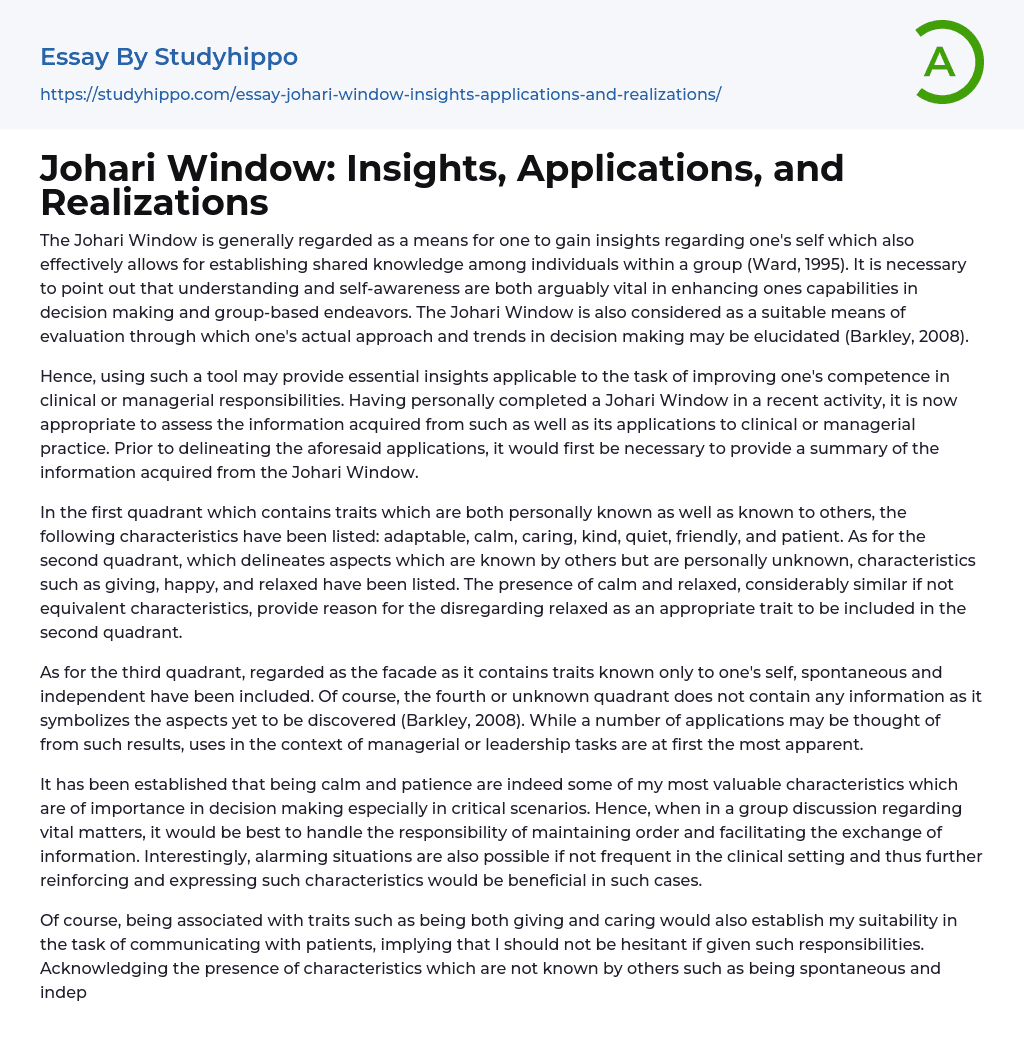

Johari Window: Insights, Applications, and Realizations Essay Example
The Johari Window is generally regarded as a means for one to gain insights regarding one's self which also effectively allows for establishing shared knowledge among individuals within a group (Ward, 1995). It is necessary to point out that understanding and self-awareness are both arguably vital in enhancing ones capabilities in decision making and group-based endeavors. The Johari Window is also considered as a suitable means of evaluation through which one's actual approach and trends in decision making may be elucidated (Barkley, 2008).
Hence, using such a tool may provide essential insights applicable to the task of improving one's competence in clinical or managerial responsibilities. Having personally completed a Johari Window in a recent activity, it is now appropriate to assess the information acquired from such as well as its applications to clinical or managerial
...practice. Prior to delineating the aforesaid applications, it would first be necessary to provide a summary of the information acquired from the Johari Window.
In the first quadrant which contains traits which are both personally known as well as known to others, the following characteristics have been listed: adaptable, calm, caring, kind, quiet, friendly, and patient. As for the second quadrant, which delineates aspects which are known by others but are personally unknown, characteristics such as giving, happy, and relaxed have been listed. The presence of calm and relaxed, considerably similar if not equivalent characteristics, provide reason for the disregarding relaxed as an appropriate trait to be included in the second quadrant.
As for the third quadrant, regarded as the facade as it contains traits known only to one's self, spontaneous and independent have been
included. Of course, the fourth or unknown quadrant does not contain any information as it symbolizes the aspects yet to be discovered (Barkley, 2008). While a number of applications may be thought of from such results, uses in the context of managerial or leadership tasks are at first the most apparent.
It has been established that being calm and patience are indeed some of my most valuable characteristics which are of importance in decision making especially in critical scenarios. Hence, when in a group discussion regarding vital matters, it would be best to handle the responsibility of maintaining order and facilitating the exchange of information. Interestingly, alarming situations are also possible if not frequent in the clinical setting and thus further reinforcing and expressing such characteristics would be beneficial in such cases.
Of course, being associated with traits such as being both giving and caring would also establish my suitability in the task of communicating with patients, implying that I should not be hesitant if given such responsibilities. Acknowledging the presence of characteristics which are not known by others such as being spontaneous and independent, emphasizes the possibility for improvement as such positive traits are innately present yet still remain non-evident.
The information provided by the Johari Window does not necessary delineate all of one's evident strengths but also lists areas which should be improved upon. Specifically, as independence and spontaneity are arguably essential in both clinical and managerial leadership, such characteristics must be further honed and expressed. Aside from such applications in terms of self realization and task suitability, using the Johari Window allowed me to realize that it may actually
be used to gain valuable information which may not readily be provided by others.
For example, a Johari Window may be modified to assess the freedom or completeness of information exchanged between patients and clinicians, allowing for more holistic and fair interactions (Sullivan & Wyatt, 2006). Therefore, aside from learning of my strengths as well as learning of points for further improvement, the Johari Window activity allowed me to accept that a proper and uninhibited means of sharing information between individuals is generally necessary if beneficial outcomes are to be expected.
- Chief Executive Officer essays
- Convenience Store essays
- Firm essays
- Training And Development essays
- Unilever essays
- Variable Cost essays
- Virgin Group essays
- Bargaining essays
- Entity essays
- Pest analysis essays
- Academia essays
- Higher Education essays
- Language Learning essays
- Studying Business essays
- Education System essays
- Study essays
- First Day of School essays
- Scholarship essays
- Pedagogy essays
- Curriculum essays
- Coursework essays
- Studying Abroad essays
- Philosophy of Education essays
- Purpose of Education essays
- Brainstorming essays
- Educational Goals essays
- Importance Of College Education essays
- Brown V Board of Education essays
- The Importance Of Higher Education essays
- Online Education Vs Traditional Education essays
- Academic And Career Goals essays
- Academic Integrity essays
- Brown Vs Board Of Education essays
- Distance learning essays
- Technology in Education essays
- Vocabulary essays
- Writing Experience essays
- Importance of Education essays
- Early Childhood Education essays
- Academic Degree essays
- Academic Dishonesty essays
- School Uniform essays
- Academic writing essays
- Cheating essays
- Bachelor's Degree essays
- MBA essays
- College Life essays
- Grade essays
- Diploma essays
- Phonology essays



